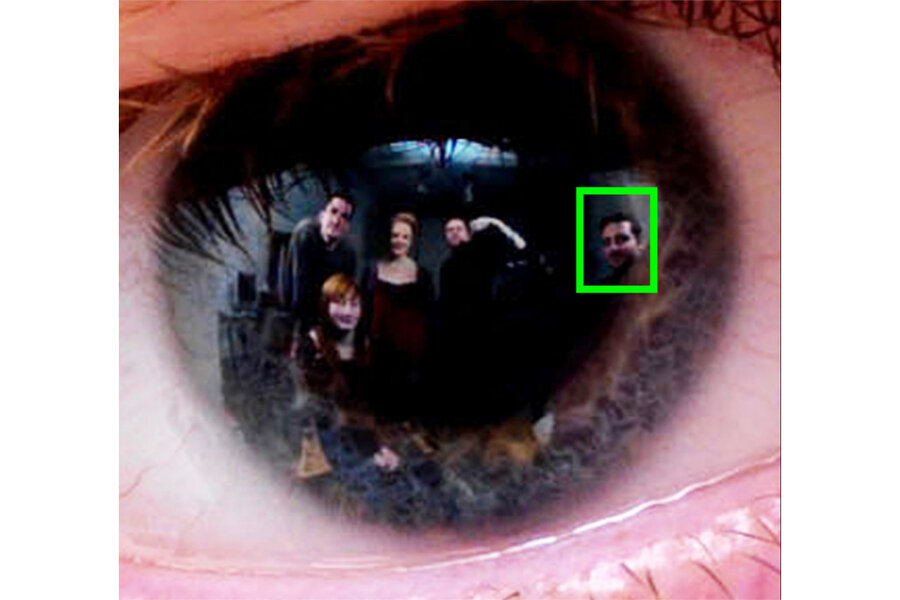New forensics technique? Researchers cull images reflected in people's eyes.
Loading...
"I get lost in your eyes," you say? Researchers are working on ways to find you and save the resulting image for posterity – or for a criminal investigation.
Scientists have found that photo portraits of an individual can yield images of the photographer or people standing close to the photographer. These additional images appear as reflections in the eyes of the photo's subject.
Even though enhancements of the reflected images appear blurry, they carry enough detail to allow others to identify the people reflected in the subject's eyes.
Several research teams are pursuing the approach, known as corneal imaging, with a range of applications in mind. Criminal forensics and surveillance, including the potential to reconstruct the immediate environment that the subject of the photo occupies, are some examples. Others include advanced computer graphics, facial and iris identification, and robotics, researchers say.
Much of this work involves close-ups of the eye, plus sophisticated computer processing, to yield sharp reflected images.
But Rob Jenkins, with the University of York in Britain, and collaborator Christie Kerr, at the University of Glasgow, have shown that useful images for identifying persons of interest in a crime don't have to be razor sharp, given humans' remarkable ability at pattern recognition. Faces can be reconstructed from images taken with commercial digital cameras and enhanced with off-the-shelf image-processing software.
Moreover, where other groups have also worked to retrieve an individual facial image or even full-length image reflected from a cornea, these results are the first to demonstrate that eye reflections can be used to identify otherwise hidden bystanders, says Dr. Jenkins, a cognitive scientist, in an e-mail.
"You could think of it as a foray into extreme facial recognition. Yes, the camera can resolve the face, and yes, the brain can identify it," he writes, "but both systems are pushed to their limits, and neither could perform the feat alone."
For the experiment, the duo used a high-end digital camera and sat each of five volunteers for a passport-photo-like shot, using studio lighting. When a volunteer wasn't being photographed, he or she stood close to the photographer to be included in the reflection off the subject's corneas.
Armed with the images taken from the reflections, as well as the original digital images, Jenkins then asked two groups of people to try to match the images. Also included were studio portraits of people not among the five photographed.
One group unfamiliar with the five photo subjects was asked whether pairs of reflected and original images matched. This group amassed a 71 percent success rate for either correctly identifying a match or ruling out a match. Another group familiar with the photo subjects averaged an 84 percent success rate.
Then, Jenkins joined the five subjects in a lineup to see how well a new group of volunteers unfamiliar with the experiment but familiar with Jenkins could spontaneously identify him from among the others. The volunteers also were asked to rate the confidence with which they could pick him out from among the group. Think police lineup here.
Nine out of the 10 volunteers correctly identified the blurry corneal image of Jenkins with a confidence level of nearly 80 percent.
The researchers hold that the corneal images not only were matchable to existing, better-quality images of the same person, but also allowed someone to identify a particular individual whom they knew.
To the researchers, this was a surprise given the poor quality of the reflection-based images.
Although the study represents an initial exploration of the potential value of extracting facial information reflected in the eyes of others, the approach's usefulness as a forensics tool is far from assured, notes Lawrence Kobilinsky, who heads the department of sciences at John Jay College of Criminal Justice in New York.
The results show "some potential for criminal investigations," he says. "But at this stage, there are too many variables that cannot be controlled in an authentic case or criminal matter."
Criminals are unlikely to be photographing kidnap or child-sex-abuse victims with big-ticket Hasselblad digital cameras with a resolution of 39 megapixels, plus carefully controlled lighting.
Moreover, in the experiments, matching the photos was still a subjective activity, essentially an opinion, Dr. Kobilinksy says. It would be far better to be able to measure some aspect of an image from a corneal reflection – say, the distance between the individual's pupils in the reflection – and compare the measurement to one from a high-resolution image of the same person. Such objective measures would inspire more confidence in any match or exclusion from a match.
Camera resolution is an issue, Jenkins acknowledges. But as the pace of technology is advancing, he adds, it won't be long before garden-variety smart phones sport 39-megapixel cameras.
Ultimately, the key to identification may rest less with the camera resolution than with the people making the identification, he writes in an e-mail.
"Obtaining optimal viewers – those who are familiar with the faces concerned – may be more important than obtaining optimal images," he writes.
The experiment's results appear in the current issue of the journal PLOS One (Public Library of Science).






